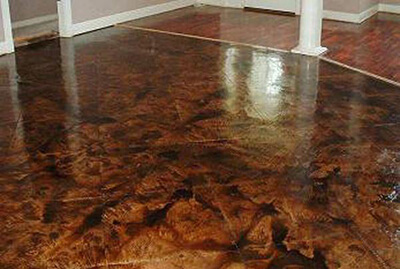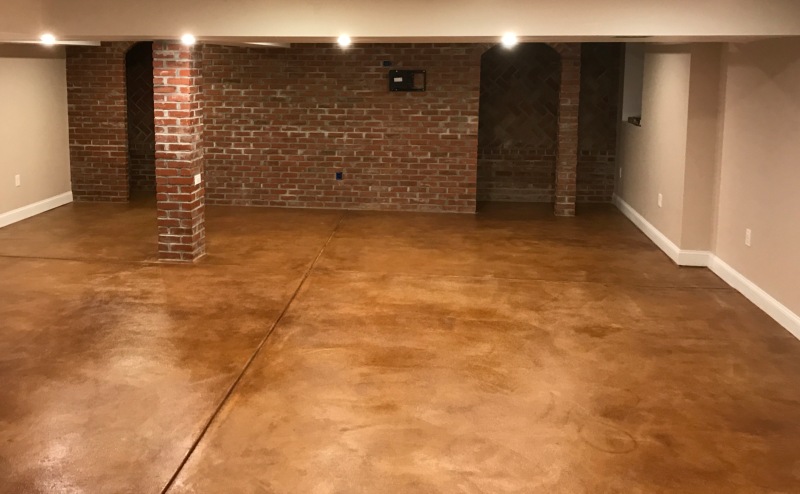Recognizing the Various Sorts Of Stained Concrete for Your Next Project
Stained concrete deals different options that provide to different aesthetic and useful demands. Each type provides distinctive qualities that influence the last look and longevity of the surface. Comprehending these differences is key for anyone intending a task. From rich, chemical responses of acid-based stains to the dynamic uniformity of strong color stains, the selections can significantly impact the end result. What elements should one think about when selecting the perfect tarnish for their certain requirements?
Introduction of Stained Concrete
Stained concrete works as a flexible floor covering option that can boost the aesthetic allure of different areas. This technique entails applying a tinting representative to the surface of existing concrete, permitting a broad range of design opportunities. Stained concrete is popular in both residential and commercial atmospheres, providing a long lasting and low-maintenance solution that can mimic the appearance of natural materials like stone or floor tile.
The discoloration process can be executed making use of water-based or solvent-based items, each giving unique visual impacts. The final look is influenced by aspects such as the initial concrete surface area, the kind of discolor used, and the application approach. Stained concrete not only enhances exterior and interiors but additionally advertises sustainability by rejuvenating existing concrete frameworks. Because of this, it has acquired traction among property owners and developers looking for both capability and design in their flooring selections.
Acid-Based Stains: Characteristics and Advantages

Distinct Shade Variants
Concrete surfaces can change significantly with the application of acid-based stains, which offer an abundant scheme of distinct color variants. These stains penetrate the concrete, responding chemically to generate vibrant earth tones that range from deep browns and reds to soft environment-friendlies and blues. The resulting colors are often variegated, producing an all-natural, marble-like look that enhances the concrete's character. Each application yields unique results because of variations in the concrete's structure and the discoloration strategy made use of, making every task unique. Additionally, acid-based stains can be layered or integrated with various other techniques to create customized designs, permitting individual expression. This convenience makes acid-based stains a prominent option for both domestic and commercial applications.
Chain Reaction Described
While several variables add to the efficiency of acid-based stains, the underlying chain reaction play an important role in their one-of-a-kind features and advantages. These stains mainly contain water, acid, and metal salts. When put on concrete, the acid reacts with the calcium hydroxide in the concrete, producing a chemical change that leads to long-term shade adjustments. The metallic salts penetrate the surface area and bond with the concrete, enabling for a wide variety of shades and tones. This response not only improves visual charm however also provides sturdiness, making the color immune to fading and wear. In addition, acid-based stains can produce a variegated finish that imitates natural rock, additional boosting their appeal for ornamental concrete applications.
Surface Prep Work Value
Accomplishing perfect outcomes with acid-based stains hinges on thorough surface area preparation. This vital step warranties that the concrete surface is tidy, devoid of impurities, and appropriately profiled for perfect stain absorption. Any kind of existing sealers, dust, or oils can hinder the chemical response that produces the preferred color and surface, bring about unequal or patchy results.
Before applying the discolor, the concrete needs to be mechanically cleaned or pressure washed, complied with by a comprehensive assessment for splits or blemishes that might require repair. Furthermore, validating the surface is sufficiently dried out will improve discolor adherence. By focusing on these primary actions, the long life and vibrancy of acid-based stains can be greatly improved, causing a much more aesthetically pleasing and long lasting surface.
Water-Based Stains: Features and Advantages

Water-based stains penetrate the concrete, offering a more clear surface that highlights the all-natural texture and variants of the surface area beneath. They are offered in a vast range of shades, allowing for innovative adaptability in design. Furthermore, water-based stains are easier to tidy up, needing just water and soap, which streamlines the application procedure.
Their quick drying time improves performance, making them a useful selection for both do it yourself enthusiasts and experts. On the whole, water-based stains provide an attractive mix of aesthetic convenience and easy to use residential properties, making them a popular option for concrete enhancement jobs.
Solid Shade Stains: Dynamic Choices for a Strong Look
Solid color stains provide an efficient service for those seeking to create a bold and vivid visual on concrete surface areas. These stains offer an uniform coloration that can see page dramatically enhance the aesthetic allure of floorings, outdoor patios, and driveways. Offered in a broad spectrum of shades, strong color stains enable for creative expression, satisfying numerous design preferences.
One of the vital benefits of solid color stains is their capability to conceal imperfections, supplying a fresh and refined want to aging concrete - stained concrete company. Furthermore, their formula generally consists of UV-resistant properties, ensuring long life and shade retention even in rough climate condition
Application is straightforward, calling for very little preparation of the concrete surface area. When used, solid shade stains can be secured for added defense and shine, further raising their aesthetic top quality. With their lively alternatives, strong color stains are an exceptional choice for those aiming for an impactful and cohesive design.
Semi-Transparent Stains: Attaining Deepness and Measurement
Semi-transparent stains use a distinct technique to enhancing concrete surface areas by giving depth and dimension via various shade options. Recognizing the application techniques is essential for achieving the wanted impact, while correct maintenance methods assure longevity. This section will discover these key aspects to make the most of the benefits of semi-transparent discoloration.
Color Options Available
A variety of color alternatives exists for semi-transparent stains, enabling house owners and designers to enhance the all-natural charm of concrete surfaces. These stains are available in a variety of tones, from natural tones like browns and terracottas to vibrant colors such as blues and environment-friendlies. The semi-transparent nature of these stains permits the underlying concrete to reveal through, developing a distinct depth and dimension that can enhance numerous design appearances. Furthermore, integrating different colors can generate custom shades, allowing a customized search for each project. This versatility makes semi-transparent stains a preferred selection for both exterior and interior applications, as they can balance with surrounding elements while adding visual rate of interest to ordinary concrete.
Application Techniques Discussed
To accomplish the wanted deepness and measurement with semi-transparent stains, correct application strategies are vital. Initially, surface area preparation is essential; the concrete must be clean and devoid of any contaminants. This commonly involves power cleaning and fixing any type of cracks. Next off, picking the ideal applicator, such as a sprayer, roller, or brush, can influence the last look. Sprayers permit for a much more even application, while rollers can assist attain structure. It is essential to apply the stain in slim, even layers, enabling each layer to dry prior to adding another. Adjusting the application method, such as varying stress or using various tools, can develop special effects. Ultimately, securing the stained surface area improves the vibrancy of the shades while offering defense.
Upkeep Best Practices
Routine upkeep is necessary for preserving the charm and integrity of surface areas treated with semi-transparent stains. To keep these surface areas, routine cleaning is essential. Using a pH-neutral cleaner and a soft-bristle broom will aid eliminate dirt and debris without damaging the discolor. It is have a peek here suggested to stay clear of severe chemicals, as they can deteriorate the tarnish's appearance. In addition, periodic resealing each to 3 years can secure against wear and fading. This procedure involves cleaning the surface extensively and using a compatible sealer developed for stained concrete. Home owners need to also keep track of for any indications of discoloration or damages and address these problems quickly to assure lasting vibrancy and longevity. Complying with these best practices will enhance the total lifespan of semi-transparent stained surfaces.
Impacts and Techniques: Personalizing Your Stained Concrete
Customizing stained concrete entails a variety of methods that enhance both looks and capability. Amongst these methods, layering various tarnish colors can produce depth and complexity, permitting unique visual effects. Techniques such as acid discoloration supply a variegated look, while water-based stains provide a much more uniform appearance.
In addition, integrating ornamental patterns, such as stenciling or engraving, can further individualize the surface area, adding detailed styles that provide to individual preferences. Texturing the concrete, whether through marking or mop coatings, introduces responsive components that not only improve grasp however also boost visual passion.
Additionally, applying sealers can enhance the shade vibrancy and offer security versus wear. Personalization techniques extend past plain color; they can transform a conventional concrete slab into a stunning centerpiece, making it appropriate for both residential and business spaces. Through mindful choice of results and techniques, stained concrete can attain a really customized appearance.
Maintenance and Long Life of Stained Surfaces
Stained concrete surface areas are understood for their durability and visual charm, preserving their integrity is necessary for guaranteeing longevity. Normal cleaning is important; sweeping and mopping with a pH-neutral cleaner aids avoid dirt build-up and discoloration. Furthermore, using a sealant every couple of years can protect the surface from moisture, chemicals, and UV damage, therefore enhancing its life expectancy.
It is also crucial to address any fractures or chips without delay. Little repair work can reduce additional wear and tear, protecting the visual and architectural quality of the surface area. For outdoor stained concrete, seasonal maintenance, such as eliminating snow and ice, is needed to stop surface damages from freeze-thaw cycles.
Frequently Asked Questions
Can I Stain Existing Concrete Surfaces or Only New Ones?
The question of whether existing concrete surfaces can be stained arises regularly. It is without a doubt feasible to stain both brand-new and old concrete, supplied the surface is appropriately ready and devoid of pollutants for perfect attachment.
For how long Does the Discoloration Process Commonly Take?
The staining process typically takes one to 3 days, depending on variables such as surface prep work, sort of tarnish, and weather problems. stained concrete. Curing time might extend past preliminary application, influencing the general period significantly
Is Stained Concrete Safe for Outdoor Usage?
Stained concrete is usually risk-free for outdoor use, provided it is appropriately sealed. This sealing shields against wetness and UV damage, making certain durability and security, while additionally enhancing the aesthetic charm of exterior spaces.
Can I Apply Several Discoloration Layers for Different Impacts?
Using numerous stain layers can achieve different results on stained concrete. It is important to ensure compatibility in between stains and permit proper drying time in between applications to stay clear of unintended reactions or discoloration.
Are There Any Type Of Color Limitations for Stained Concrete?
Shade constraints for stained concrete primarily depend on the check out this site type of discolor utilized, with water-based stains offering a wider palette compared to acid-based stains. stained concrete contractors. However, achieving vivid colors might call for mindful option and application strategies